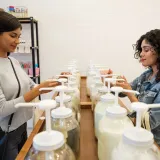

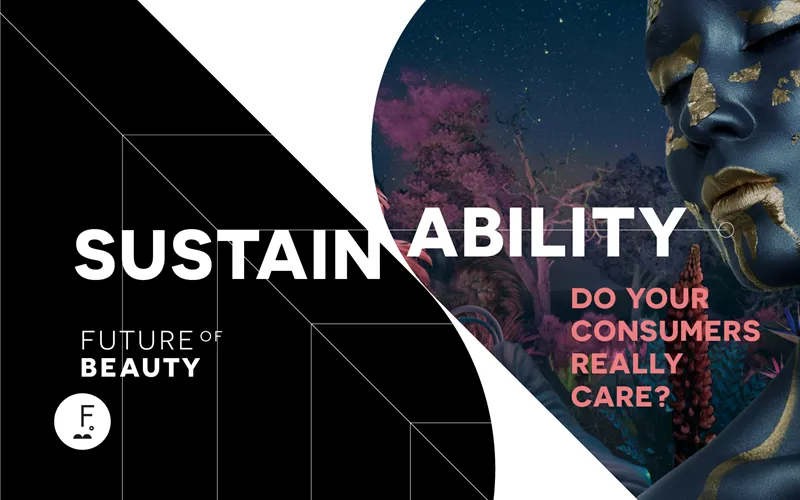
SUSTAINABLE BEAUTY: GOAL OR OXYMORON?

The question is probably even more stark if you substitute ‘Health & Beauty’ with Fashion. Taken to it’s extreme, fashion can never be sustainable, as Patagonia – paragons of sustainability – point out “. . . you can try to achieve a situation where you’re causing the least amount of harm possible – and that’s with ‘regular’ clothes, ones that Patagonia will take back and repair.
The impossibilty of total sustainability is neatly summed up by the tagline of fellow clothing brand Reformation:

Perhaps this is why there seems to be a sense of guilty indulgence about beauty in particular and a challenge for health & beauty brands. ‘Looking good at the expense of the planet’ isn’t something many consumers are going to resonate to.
So, after our in-depth investigation into the attitudes of Gen Z to health and beauty: Is your brand ready for Gen Z? Pull decided to turn our attention in our next round of consumer research to what is fast becoming the hottest topic in Health & Beauty – Sustainability.
The academics seem to be in dispute about the consumer impact of a brand’s sustainability:
Dr. Matt Johnson, professor at Hult International Business School and founder of neuromarketing blog Pop Neuro, says, "There is accumulating evidence that consumers are impacted by the perceived sustainability of [a] brand, and further, that consumers are willing to pay a premium for products from a sustainable brand over a non-sustainable competitor brand." Whereas Mark Ritson took a different view in Marketing Week a couple of years ago:
With no real axe to grind, and in the spirit of providing data-driven insights for brands actually facing the sustainability challenge, we decided to find out.
- What do consumers REALLY think about sustainability of brands?
- What do they actually DO about it?
- What do they even think sustainability means?
- What aspects of sustainability worry them most?
- Who influences them over sustainability?
We were highly conscious of the limitations of self-reporting surveys in identifying what people say they do and what they actually do (as pointed out by Mark Ritson in the article linked-to above). But we think we found some good ways to get round people’s natural enthusiasm for being seen to support good causes which isn’t reflected in their actions.
PLEASE DOWNLOAD THE FULL REPORT, BUT HERE IS OUR TAKE ON THE KEY FINDINGS.
The meaning of ‘Sustainability’ is not very clear to consumers.
Interestingly the older the consumer, the more they agreed with the dictionary definition of sustainability: ‘Renewing, regenerating and conserving resources we use’. While nearly half of Baby Boomers chose this as their definition, only 29% of Gen Z did.
Given the plethora of competing interests embraced under ‘sustainability’ – pollution, cruelty, profligate use of natural resources, exploitation – for those interested in persuading others to do the right thing, it’s a little disappointing that more people don’t ‘get’ this umbrella term.
On the other hand. . .
People believe that they – not governments or brands – are the most responsible for caring for the planet.
Again, arguably Baby Boomers lead the way with 82% reflecting this point of view vs. 64% of Gen Z. Some will find it encouraging that consumers are not passing the buck to government and business, but consumers see themselves as autonomous agents whose choices will shape the world of the future. Others who see government and corporate actions as critical to action in sustainability might be disappointed.

Taken with evidence about who influences them when it comes to brand choices in sustainable beauty (see below), brand owners may want to reflect that consumers seems to want to be helped, not dictated to or hectored.
Diana Verde Nieto is the CEO of Positive Luxury, the company behind the Butterfly Mark, a sustainability standard for luxury brands. Speaking as part of our Future of Beauty panel, she was keen to point out that government, brands and the consumer aren’t the only parties in the equation:
“The consumer is old news! The ‘new black’ is the investment community – money talks. This is the first time in history that the investment community is in tune with activists and environmentalists! Now investors are saying: ‘We will only invest in those companies who can demonstrate their commitment to sustainability”.
Plastic waste worries people most.
60% of consumers identify plastic waste and the ability to recycle that waste as being the number one sustainability challenge.
Yet perhaps surprisingly, speaking on our panel, Daniel Murray, the WWF’s Senior Partnership Development Manager, didn’t see this as the top issue and had another take:
“Plastic is the most tangible and visible – you can see the effect. But you have to be aware of the impact of what goes in the bottle as well. We are especially concerned with fresh water. I actually think that fresh water is the number one issue”
Nevertheless, the single thing that consumers in this category would most like manufacturers to do is to reduce packaging. The fact that plastic waste looms very large for consumers is reinforced by the fact that in terms of certification symbols…
People look for recycling-related symbols most.
Perhaps this is because it is actionable. People want to do the right thing. Being confident that they can recycle their empty pack is re-assuring. What is also clear is that the plethora of symbols is confusing. While specific symbols around say – vegan or organic – will appeal to section of users, there is currently no one way in which brands can demonstrate that they have met a certain threshold of overall sustainability.
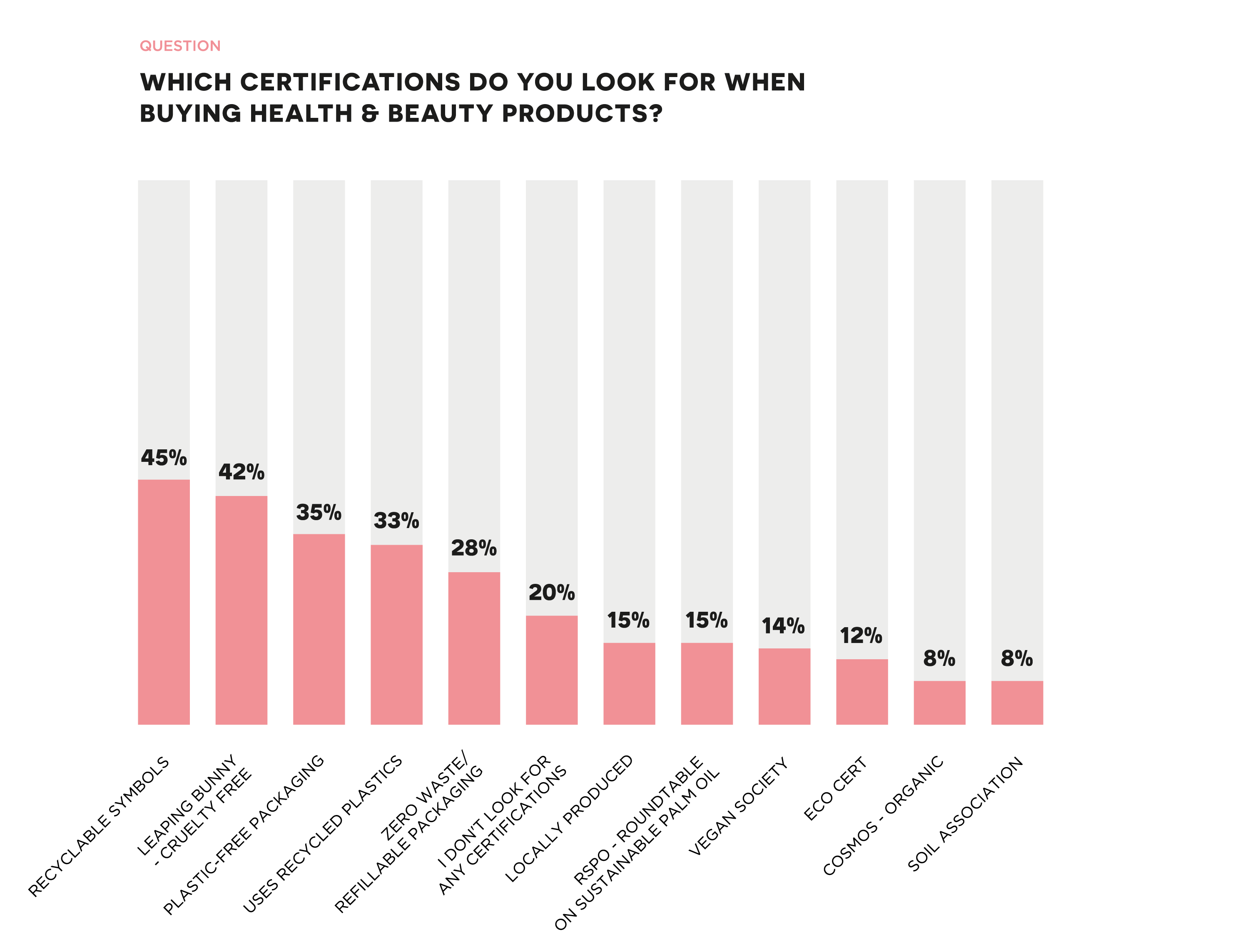
Consumers want to think the brands they like are sustainable.
This observation is based on a certain amount of interpretation. Only 12% of respondents said that sustainability wasn’t a priority when purchasing health and beauty products. While it remains difficult to determine to what extent this translates to impact on actual product selection and purchase, if 88% say that sustainability is important to their product selection, it doesn’t seem unreasonable to assume that if they like your brand, they would also like assurance that it is sustainable.
To inject a note of caution, it is worth recognising that while sustainability is a factor behind product consideration, it is still a subsidiary one.
All generations were in agreement that proven results, affordability and quality come before sustainability.

This provides a clear pecking order of consumer needs and should serve as a steer for brand owners: consumers want their health and beauty brands to be sustainable, but they first have to affordably provide their principal function and meet a quality threshold. Put simply – people won’t buy products that make sustainability claims, but don’t work.
Nevertheless, it is worth bearing in mind that 19% of consumers did say that they would pay more for a more sustainable brand. Carolina Cordero, International Marketing Manager at Nature Box (Henkel) throws a curveball here too:
“Being sustainable can mean an increase in the cost of your goods. But at the end of the day, if you are not prepared to take a hit on our cost of goods in order to do good then I think you need to take a long hard look at yourself. Look at your own P&L. I might have to reduce my margin in order to give something back to the planet – but you should win in the long run if you get the consumer on your side. Take a hit to do good”
So, brands might have an alternative. Use more sustainable ingredients and maintain affordability with lower margins – something for brands to chew on.
Brands as influencers
This was the biggest surprise from our research. Health & Beauty consumers are most influenced by brands (this is most true of the older generations, both Gen Z and Millennials are slightly more likely to be influenced by friends and family) and least by activists like Greta Thunberg and even broadcasters like Sir David Attenborough or organisations like Greenpeace. However, it didn’t seem much of a surprise to our panellists.
“I’m not surprised [brands have more influence than activists]”, says Carolina. “Brands have an active dialogue with consumers, they are part of our lives day-to-day, so I’m not surprised they have a big influence, whereas activists are trying to disrupt”.
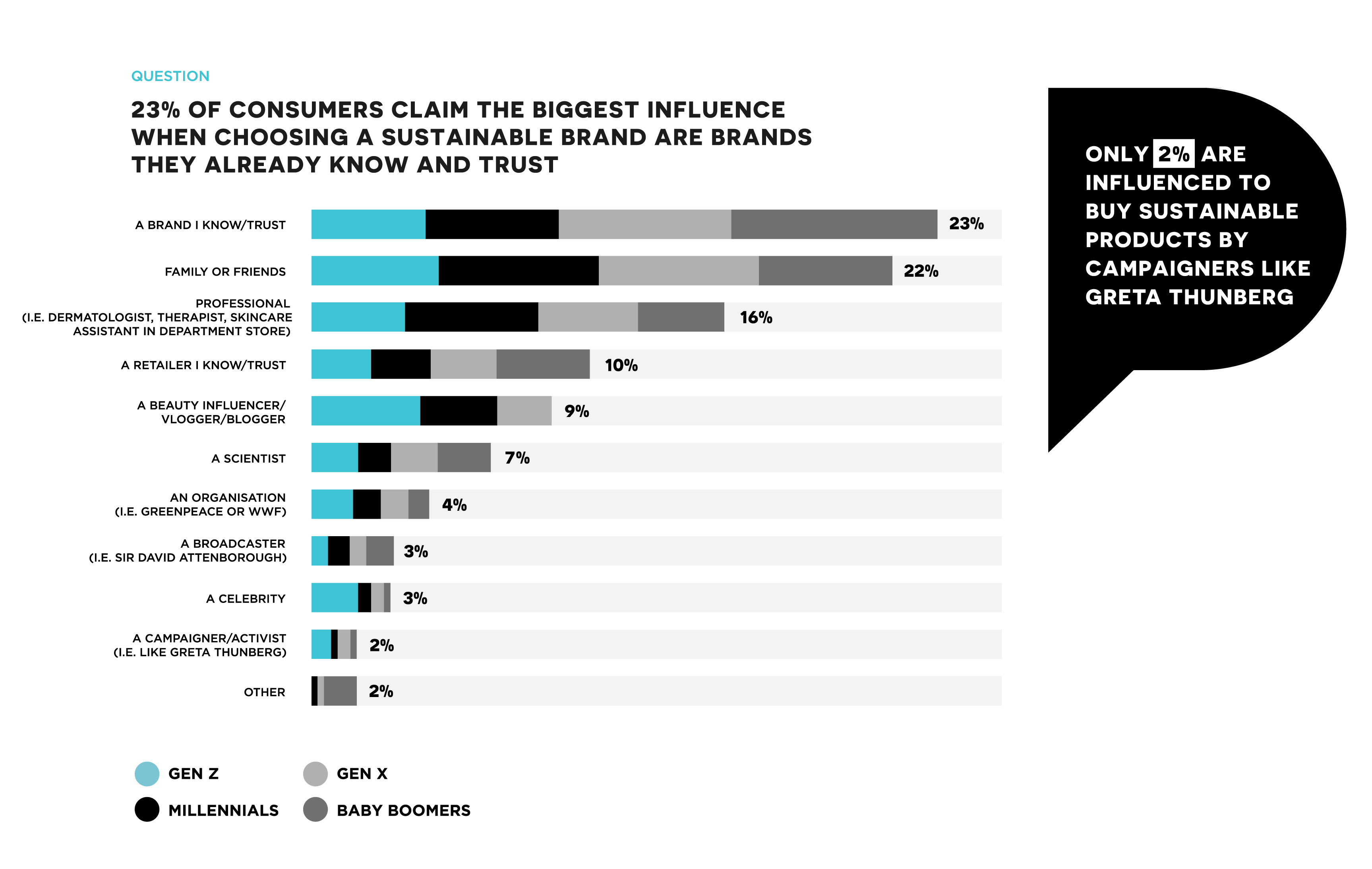
We read this to mean that when looking at a new, more sustainable product proposition, the single most influential element for consumers is the brand who’s making the proposition. This would suggest there is a significant opportunity for the larger, established brands to launch sustainable variants. In that context it’s very interesting to see Procter & Gamble launch a sustainable shaving brand – Planet Kind – but note the small version of the Gillette brand on the packaging. Although this is a dual-branding approach we have never known P&G to take before, it looks as though P&G is adopting a strategy implied by our research: give people the double re-assurance of a brand that they know is effective, but with dramatically-improved sustainability credentials.
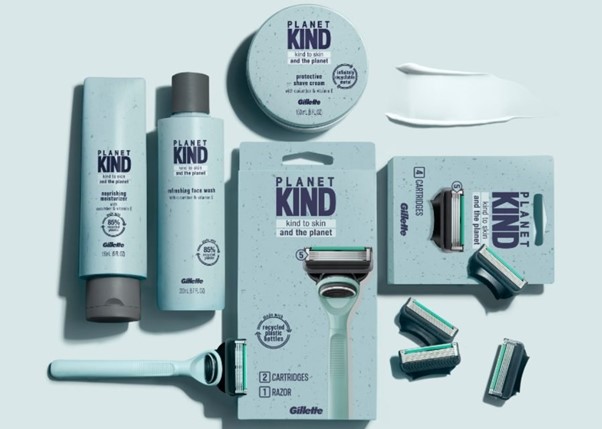
P&G know what they are doing brand marketing-wise. Who would have thought it?
And Finally:
People exaggerate their sustainability credentials. Only 10% think people do what they say when it comes to sustainability.
This is why we asked a control question.
50% of consumers believe ‘others’ exaggerate their commitment to sustainability, and this belief is stronger among those under 40. Could it be that Gen Z in particular – regularly attributed with much stronger allegiance to purpose-driven and sustainable brands – might be engaging in a bit of virtue-signalling? More than any other generation we surveyed, Gen Z thought their friends were less than honest when it came to what they claimed and what they did – and they were the surest about it.

So then, what’s a health & beauty brand manager to do about sustainability?
We think there are lessons here for both the new generation of agile, often DTC-orientated brands, and the older established ones who once dominated the market via the high street.
For the newer, smaller brands: concentrate on effectiveness and value for money while leveraging the inherent advantage of appearing a challenger to the bad boys of the old health & beauty school. People may choose you because of your sustainability credentials, but they will only come back if your product is efficacious and doesn’t carry an eye-watering premium.
For the established brand names: retain your product efficacy and value-for-money formula but take a bold step for sustainability. Planet Kind looks like a great role model. We suspect that P&G won’t shed tears if Planet Kind cannibalises ‘traditional’ Gillette. It sells at a premium – and the more consumers happy to pay it, the happier both the planet and P&G will be.
Our panel also had some great advice for any health & beauty marketing professionals out there. And some great advice from Carolina from Nature Box:
“Marketers have a lot to juggle,” Carolina says, “but be curious, learn about transportation, how much water is used in your factory. Know what goes on everywhere. Most people don’t realise that the consumer’s shower represents the largest energy consumption in the value chain”.
And for the industry?
Sustainability is a compendium of elements which are individually competing for the consumer’s attention. Environmentalism is also a fragmented cause. The concept of sustainability however, is end-to-end, all-embracing and not difficult to understand when explained.
It does seem that there is an opportunity for the industry to agree a sustainability award or index and associated mark. The apps mentioned in our full report – Think Dirty, Giki Yuka and Healthy Living are already leading the way in this area.
According to Diana from Positive Luxury, sustainability ratings are coming: “There is an approach coming based on an ‘A – E’ scoring – somewhat like energy consumption for domestic appliances”.
Perhaps the health and beauty industry should participate in the development of these standards?
Posted 1 March 2021 by Chris Bullick